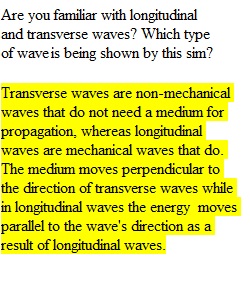


Q Sound and Wave Basics Name: _________________ Use the PhET sim Wave on a String for questions 1-6. https://phet.colorado.edu/sims/html/wave-on-a-string/latest/wave-on-a-string_en.html Play around and get familiar with the sim first. Be sure to try out all the buttons. 1. Are you familiar with longitudinal and transverse waves? Which type of wave is being shown by this sim? 2. Use arrows, or draw on the wave, to show what will happen when the amplitude is increased: 3. Use arrows, or draw on the wave, to show what will happen when the frequency is increased: 4. What direction does each individual part of the string move when a wave travels along it? 5. What direction does the actual wave move (hint, try pulse)? Use the Sound sim from PhET for questions 7 – 11. Play around and get familiar first. Select Audio Enabled to hear the sound. 6. Which type of wave is being shown by this sim - longitudinal or transverse? 7. When you change the frequency, how does the sound change? 8. How does the model that you see change when you change the frequency (include a diagram)? 9. How does changing the amplitude affect the sound you hear and the model that you see?
View Related Questions